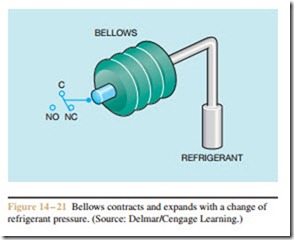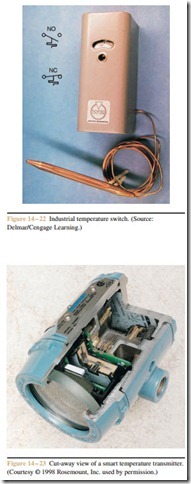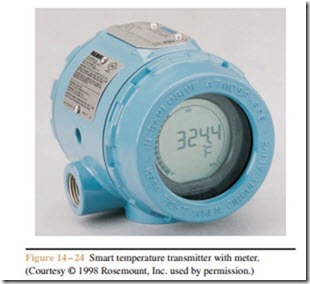Smart Temperature Transmitters
Standard temperature transmitters generally send a 4 to 20 milliampere signal to indicate the temperature.
They are calibrated for a specific range of temperature such as 0 to 100 degrees. Standard transmitters are designed to operate with one type of sensor such as RTD, thermocouple, and so on. Any changes to the setting require a recalibration of the unit.
Smart transmitters contain an internal microproces- sor and can be calibrated from the control room by sending a signal to the transmitter. It is also possible to check the transmitter for problems from a remote loca- tion. A cutaway view of a smart temperature transmitter is shown in Figure 14 – 23. The transmitter illustrated in Figure 14 – 23 uses HART (Highway Addressable
Remote Transducer) protocol. This transmitter can ac- cept RTD, differential RTD, thermocouple, ohm, and millivolt inputs. A smart temperature transmitter with meter is shown in Figure 14 – 24.
Review Questions
1. Should a metal bar be heated or cooled to make it expand?
2. What type of metal remains in a liquid state at room temperature?
3. How is a bimetal strip made?
4. Why are bimetal strips often formed into a spiral shape?
5. Why should electrical contacts never be permitted to open or close slowly?
6. What two factors determine the amount of voltage produced by a thermocouple?
7. What is a thermopile?
8. What do the letters RTD stand for?
9. What type of wire is used to make an RTD?
10. What material is a thermistor made of?
11. Why is it difficult to measure temperature with a thermistor?
12. If the temperature of an NTC thermistor increases, will its resistance increase or decrease?
13. How can a silicon diode be made to measure temperature?
14. Assume that a silicon diode is being used as a temperature detector. If its temperature increases, will its voltage drop increase or decrease?
15. What type of chemical is used to cause a pressure change in a bellows type thermostat?


